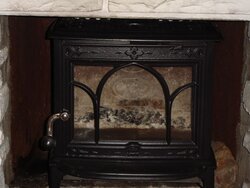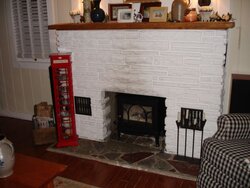Hi Everyone,
I installed a Jotul F100 QT last year and it's performance was less than spectacular.. It seemed to be working well in the fall, but then in early December I had to stop using it because it took forever to get a fire started, drafted poorly, etc. Before I go any further, let me give you a quick run through on my configuration:
Stone fireplace with what I believe was called a "heatilator" insert. (Metal firebox) I lined the chimney (13') with a 6" stainless liner and a cap.
The wood stove is inserted into the fireplace, and is connected to the liner which runs up to the top of the chimney. (The chimney is stone, but lined with clay sections)
When I originally installed the stove, I had to "ovalize" the liner to get it past the opening at the top of my metal fireplace firebox and into the chimney. I think this may have been contributing to my problem. I pulled out the stove in Feb and decided that maybe the jog that the liner was taking out of the top of the old metal fireplace firebox could be part of my problem. I took a sawzall and basically cut out the top of the old Heatilator firebox. (It was rusted and unusable, anyway). This gave me clear access up to the flue lined chimney.
I went ahead and connected the stove back up and had somewhat better results. My fires started faster once I warmed up the flue (by stuffing newspaper above the burn plate and lighting it...) I never seem to have enough draft, though.. I wind up always cracking the door a small bit to induce more air for draft.
I suppose that some of my problem could have been my firewood.. (I had split 3 cords delivered in the summer, and I have a feeling they were not as seasoned as promised) With any luck, the wood was a big part of my problem and this year will yeild much better results.
Here is my question: Does anyone think that I'd obtain any additional draft by venting the stove directly into the clay lined chimney, instead of running the liner all the way to the top? I had the chimney inspected and it's in very good condition. To me, it looks like I'd obtain better draft via the clay lining, instead of the corregated stainless liner. If I did connect directly to the chimney, how do I go about making the connection to the clay lining at the firebox?
As always, thanks to all for your advice! Looking forward to fall
Scott
Scott
I installed a Jotul F100 QT last year and it's performance was less than spectacular.. It seemed to be working well in the fall, but then in early December I had to stop using it because it took forever to get a fire started, drafted poorly, etc. Before I go any further, let me give you a quick run through on my configuration:
Stone fireplace with what I believe was called a "heatilator" insert. (Metal firebox) I lined the chimney (13') with a 6" stainless liner and a cap.
The wood stove is inserted into the fireplace, and is connected to the liner which runs up to the top of the chimney. (The chimney is stone, but lined with clay sections)
When I originally installed the stove, I had to "ovalize" the liner to get it past the opening at the top of my metal fireplace firebox and into the chimney. I think this may have been contributing to my problem. I pulled out the stove in Feb and decided that maybe the jog that the liner was taking out of the top of the old metal fireplace firebox could be part of my problem. I took a sawzall and basically cut out the top of the old Heatilator firebox. (It was rusted and unusable, anyway). This gave me clear access up to the flue lined chimney.
I went ahead and connected the stove back up and had somewhat better results. My fires started faster once I warmed up the flue (by stuffing newspaper above the burn plate and lighting it...) I never seem to have enough draft, though.. I wind up always cracking the door a small bit to induce more air for draft.
I suppose that some of my problem could have been my firewood.. (I had split 3 cords delivered in the summer, and I have a feeling they were not as seasoned as promised) With any luck, the wood was a big part of my problem and this year will yeild much better results.
Here is my question: Does anyone think that I'd obtain any additional draft by venting the stove directly into the clay lined chimney, instead of running the liner all the way to the top? I had the chimney inspected and it's in very good condition. To me, it looks like I'd obtain better draft via the clay lining, instead of the corregated stainless liner. If I did connect directly to the chimney, how do I go about making the connection to the clay lining at the firebox?
As always, thanks to all for your advice! Looking forward to fall

Scott
Scott



